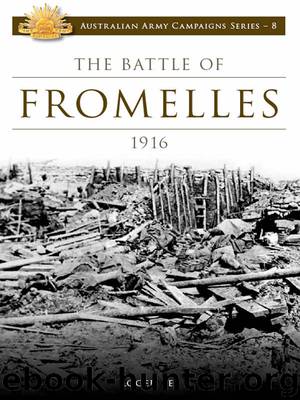The Battle of Fromelles by Roger Lee

Author:Roger Lee
Language: eng
Format: epub
ISBN: 9780980658293
Publisher: Big Sky Publishing
German map showing plotted location of British artillery firing during the battle. Map supplied as part of a report by Peter Barton on his research on behalf of the Australian Army in the Hauptstaatsarchiv Kriegsarchivin Munich, Germany.
Ordnance QF 18-pdr Gun
Calibre: 83.8mm (3.3in)
Weight: 1284kg
Crew: Six
Rate of Fire: 20rpm (max); 4rpm (sustained)
Effective Range: 6000m max (in 1916)
Manufacturer: British arsenals and in Allied countries under licence
Accepted for service by the British Army in 1904, the QF (Quick Firing) 18-pdr was the standard field gun of all Commonwealth armies in World War One with almost 300 shipped to Australia in 1906 for use by the various militia artillery units. While the gun had been improved by 1916, it proved inadequate for the primary role of artillery on the Western Front — the destruction of fortifications, trench-lines and barbed wire. Firing mainly shrapnel shells on a relatively flat trajectory, the 18-pdr’s shells had little penetrating power. Even by the Battle of Fromelles, when the shortage of high explosive ammunition had been addressed, the 18-pdr remained relatively ineffective against all but enemy troops in the open, witnessing the rise of larger and heavier calibre guns. Towed by a limber containing twenty-four rounds of ammunition and team of six or eight horses, the gun was usually dug in when deployed on the Western Front. The 18-pdr field gun’s comparatively short (by modern standards) range necessitated its location as far forward as possible in order to extend its reach into the enemy’s rear areas. Smaller calibre guns were located between 900 and 2,700 metres from the front line, while the heavier calibre guns were located further to the rear. This meant that the guns were often located immediately behind the forward battalions, a practice not without its hazards. At the battle of Lagnicourt in April 1917, the guns from all four batteries of the 2nd Australian Field Artillery (AFA) Brigade, together with the three field batteries of the 1st AFA Brigade, were captured in a German counter-attack.
Download
This site does not store any files on its server. We only index and link to content provided by other sites. Please contact the content providers to delete copyright contents if any and email us, we'll remove relevant links or contents immediately.
The Radium Girls by Kate Moore(11592)
100 Deadly Skills by Clint Emerson(4674)
The Templars by Dan Jones(4549)
Rise and Kill First by Ronen Bergman(4538)
The Doomsday Machine by Daniel Ellsberg(4234)
The Rape of Nanking by Iris Chang(4006)
Killing England by Bill O'Reilly(3893)
Hitler in Los Angeles by Steven J. Ross(3790)
Stalin by Stephen Kotkin(3715)
12 Strong by Doug Stanton(3409)
Hitler's Monsters by Eric Kurlander(3148)
Blood and Sand by Alex Von Tunzelmann(3045)
Darkest Hour by Anthony McCarten(3011)
The Code Book by Simon Singh(2840)
The Art of War Visualized by Jessica Hagy(2826)
Hitler's Flying Saucers: A Guide to German Flying Discs of the Second World War by Stevens Henry(2618)
Babylon's Ark by Lawrence Anthony(2422)
The Second World Wars by Victor Davis Hanson(2416)
Tobruk by Peter Fitzsimons(2369)
